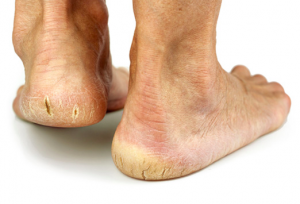Cracked heels describe the little cracks that occur around your heels after they have built up with dry skin (callus). Cracked heels affect the outer layer of the skin (epidermis). They can be uncomfortable, frustrating and sometimes painful if the cracks are deep enough to crack into the healthy skin beneath the callus (dermis).
How do you get cracked heels?
 The first step in getting cracked heels is getting a build up of dry skin (callus) around your heels. Callus often occurs as a result of excessive force and pressure through an area of the skin, which in this case is the heels. Various causes include:
The first step in getting cracked heels is getting a build up of dry skin (callus) around your heels. Callus often occurs as a result of excessive force and pressure through an area of the skin, which in this case is the heels. Various causes include:
- Standing or walking for long periods of time
- Barefoot walking
- Lots of force on the heels when walking (as a result of the way the foot functions)
- Not supplementing moisture back into the skin
- Open-backed shoes
- Walking on hard surfaces
- Very hot showers and baths for a prolonged time
- Obesity (increased weight means more pressure through the heels)
- Diabetes
Building up callus is a natural body process to protect areas of the skin that are under a lot of pressure and at a high risk of damage. When the callus loses a lot of moisture and is subject to pressure, cracks form.
What are the symptoms?
Aside from the obvious cracks in the callus around you heals, you may experience:
- Dry, itchy heels
- Hard skin on the heels
- Pain when standing and walking
- Bleeding or discharge
Another cause of itchy, dry-looking feet can be Athlete’s Foot –
click here to learn more.
Why is treating cracked heels important?
Cracks in the dry skin can also crack the healthy skin beneath the callus. This will cause it to bleed and become painful. It will also be very vulnerable to infection, as the cracks can easily trap dirt and bacteria and be difficult to clean.
We’re able to treat and manage your cracked heels safely and effectively. We can:
- Safely remove layers of callus to reduce the overall bulk
- Check for signs of infection and take appropriate action to get it sorted where needed
- Dress any open cracks and advise you on the best way to protect them
- Identify likely causes of your cracked heels to reduce the likelihood of them recurring
- Recommend emollients (skin softeners) to help your cracked heels at home
Moisturising your heels daily can help with cracks. Improving circulation to the feet can help heal cracks and discourage them from recurring. If cracks or deep fissures are persistent, a diet lacking proper nutrients may be the culprit. Your Podiatrist will be able to give you the best advice and treatment plan that is specific to your symptoms.
We remove thick, hard cracks from the heels in our
medical pedicure and
skin and nail care appointments.
 The first step in getting cracked heels is getting a build up of dry skin (callus) around your heels. Callus often occurs as a result of excessive force and pressure through an area of the skin, which in this case is the heels. Various causes include:
The first step in getting cracked heels is getting a build up of dry skin (callus) around your heels. Callus often occurs as a result of excessive force and pressure through an area of the skin, which in this case is the heels. Various causes include:








